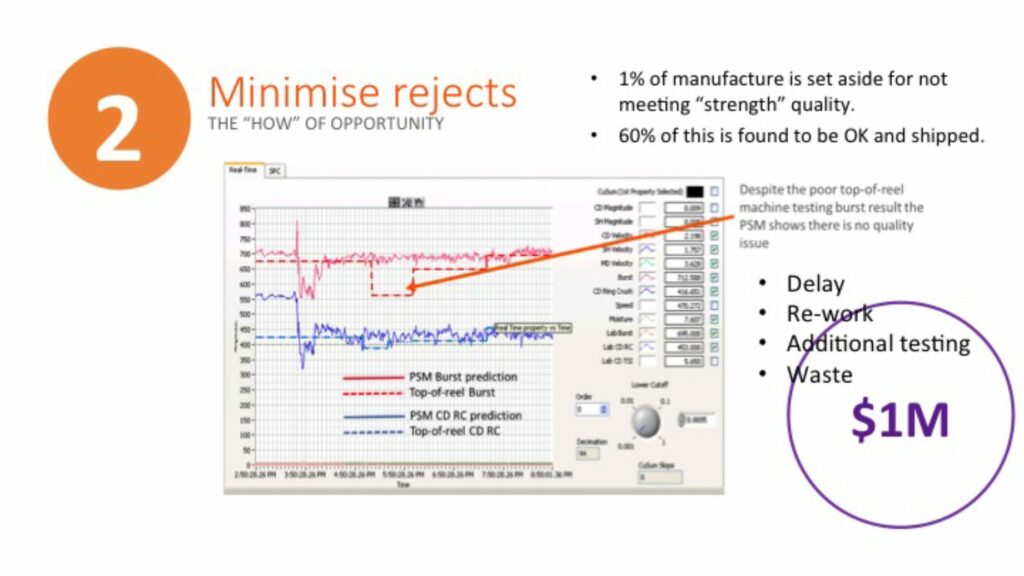The Uncertainty Principle & The Paper Machine
With regard to control of paper performance variability there are three issues that must be confronted:
- Natural materials are variable (you can’t take all your wood from the north side of the hill).
- Time lags in the manufacturing process (what you see isn’t what you get)
- Poor quality testing (you don’t test all the paper you make)
- In line with this understanding how do you answer the following questions?
- Is the paper I am making today the same as the paper I made yesterday?
- Will the paper I make today perform as well in its end-use application as it did yesterday – for example, survival time in corrugated boxes?
- Have I minimised the cost of the paper I am making at every moment of production?
- Have I optimised the paper making process at every moment of production?
These are all interesting and relevant questions and the one thing they have in common is “time”. It is interesting that in many cases the answer to these questions is limited by how often information is received. I intend to discuss these issues separately in coming weeks. Feel free to join in. Of course the point of all this thinking is money! Our work with continuous paper measurement on real paper machines suggests that property variation costs a typical paper machine between $10 -$20 million dollars a year! How? That is the topic of a future blog, but here is a start.
I have recently been reading the book by Brian Greene, “The Fabric of the Cosmos, Space, Time and the Texture of Reality”, and I was pleased to see that like the universe, where there is uncertainty in measurement, a statistical measure for making judgements has to be applied. This all sounds very vague and difficult, but really says that if you don’t know something exactly you have to “guess” a value within an expected range. Within that range some values are more likely than others. Measurement on the paper machine has its own uncertainty and although not quite like the quantum mechanical considerations particle physicists have to make, it is still worth considering the outcomes from this sort of limitation on the paper machine (This analysis formed the basis of a paper at Appita conference in Melbourne in 2013, “Concepts to maximise benefit from on-line strength measurement, R.J. Allan)
Paper machine engineers are used to applying statistical control techniques to the machine – but do we know what it means with respect to our ability to make decisions? If we set as our criteria, the quite stringent (from an engineering point of view), but reasonable from a desirable point of view, criteria that we need 98% confidence that a change is warranted before making an adjustment then we find that; an early warning for loss of control appears to require between 2 and 5 top of reel measurements – representing between 3 and 7 hours of running time – depending on how often top of reel testing is undertaken. To be convinced that action is needed to maintain control would need 6 to 15 top of reel measurements (9 to 22 hours) depending on the type of quality failure. Of course, less stringent statistical criteria lower the requirement.
One conclusion from this striking result is inability to determine the paper performance quickly and with confidence means that for many makings in a grade production sequence it is not possible to move the operating point meaningfully within the grade run. The machine operator, starved for statistically significant paper test data, simply runs out of time before a meaningful judgement can be made.
A second and more embedded (intractable) issue relates to the long standing design of the paper machine and delivers a challenge to paper machinery manufacturers. In broad terms, the paper machine has been historically designed with large forward capacity in its approach system. The aim of such a large capacity is to minimise the transfer of upsets or changes through the system and to smooth out the effects as they would be seen at the paper machine. In a system that has low reporting data rates and can be, potentially, very noisy (in an information sense), this strategy has important advantages. However, there are disadvantages to such a system that under these conditions have to be accepted. In general terms these disadvantages relate to “time” again.
Paper machines also exhibit a sizeable time lag between process changes on the paper machine (cause) and their consequence observed on the paper machine (effect).
Finally, the limitations of the measurement – perhaps a small sample every hour or so at the roll turn up (0.00001% of manufacture) – to properly describe the total amount of paper manufactured have a direct impact on the number of samples needed to make a judgment. Given the measured variation in reported results, the confidence associated with a particular top-of-reel measurement usefully representing the entire reel is very low and this implies that the time needed to judge whether adjustments are warranted become correspondingly long.
Given all of the above, in some short grade runs, say less than 20 measurements (20-40 machine rolls) there is probably no compelling reason for a machine operator to make any adjustments to the machine at all – he would probably be best sitting on his hands until the next grade change!
What the paper machine needs to help the situation are two things:
- More timely (faster) paper performance data
- Responsive machine actuation or levers that allow adjustments to be made in a timely manner.


Your Presenter: Russell Allan
Managing Director, Aurelia Group Consulting
Editor of the APPITA Magazine
If on your paper machines, you need to minimise input costs, lower quality variability, minimise reject material and understand in more detail how paper machine process affects paper quality then you will find this webinar very useful.You’ll be surprised how easy the PSM-4 is to install and commission.
Once installed, find out how you can benefit from the PSM-4 sensor and the amazing things you can do with this new technology.
From this webinar, you will come away with a good understanding of the requirement for applying Aurelia’s on-line stiffness measurement to your paper machine as well as ideas for how you can generate benefit in your paper making operations.




